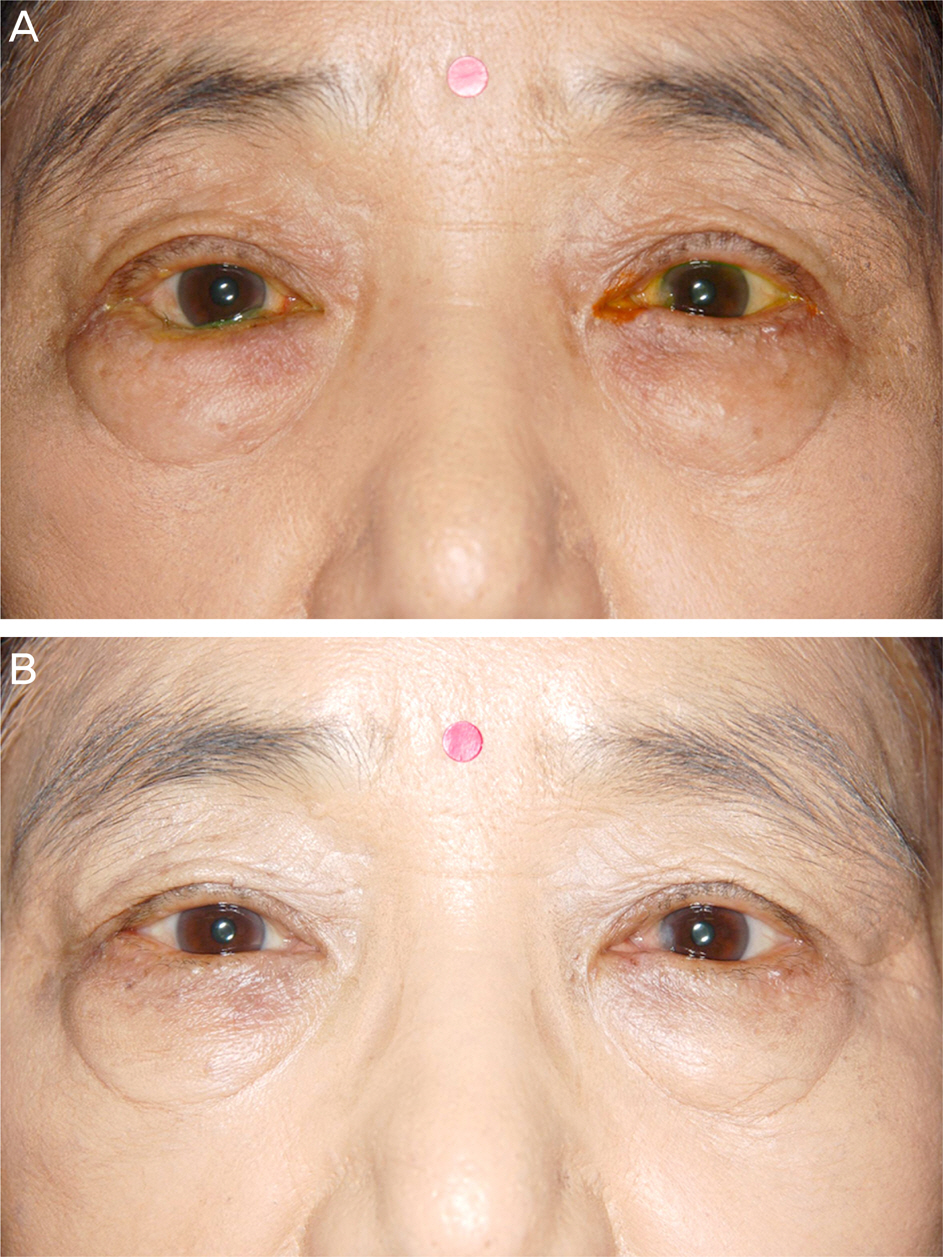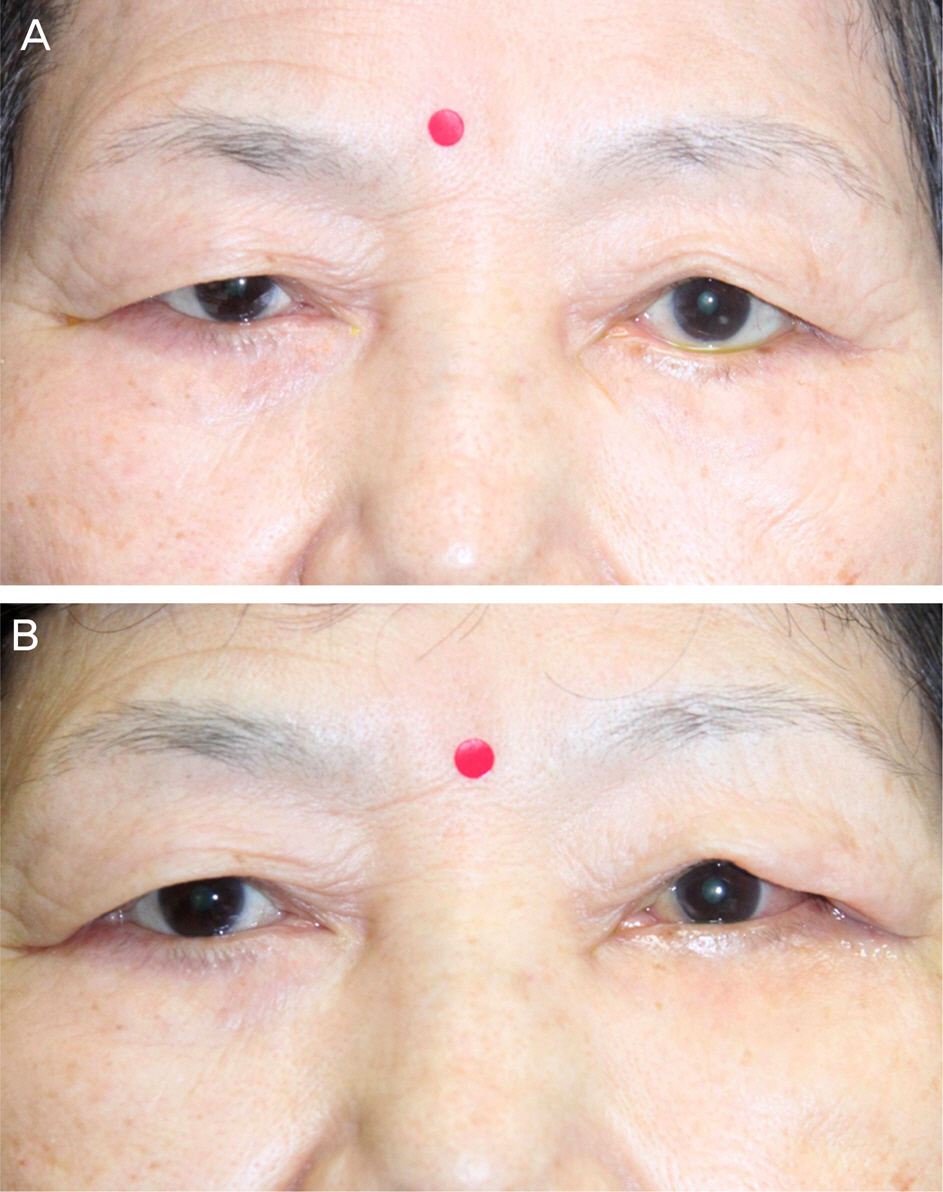J Korean Ophthalmol Soc.
2015 Jun;56(6):803-810. 10.3341/jkos.2015.56.6.803.
Clinical Effectiveness of the Lateral Tarsal Strip Procedure
- Affiliations
-
- 1Department of Ophthalmology, Korea University College of Medicine, Seoul, Korea. shbaek6534@korea.ac.kr
- KMID: 2339142
- DOI: http://doi.org/10.3341/jkos.2015.56.6.803
Abstract
- PURPOSE
To evaluate the clinical indications and efficacy of the lateral tarsal strip procedure.
METHODS
The medical records of patients who underwent the lateral tarsal strip procedure between September 2008 and February 2014 were retrospectively reviewed. We examined age, gender, diagnosis, procedures simultaneously performed with the lateral tarsal strip, duration of observation, postoperative complications and cases requiring revision surgery. Patients without recurrence or undercorrection of eyelid/lateral canthal area lesions, surgical complication and not requiring revision surgery until final visit were considered as successful cases.
RESULTS
One hundred eighty-three eyes of 129 patients were included in this study. The mean patient age was 61.6 years and average follow-up duration was 9.2 months. Diagnoses of eyes were lower lid laxity (39.9%), involutional entropion (24.0%), lower lid retraction (14.8%), cicatricial ectropion (6.6%), lateral canthal deformity (5.5%), involutional ectropion (3.8%) and paralytic ectropion (2.7%). Surgical procedures simultaneously conducted with lateral tarsal strip in 167 eyes of 183 eyes were endoscopic dacryocystorhinostomy (30.5%), lower retractor tightening (19.2%), medial spindle procedure (13.8%), mid-lamellar lengthening (12.6%), lower blepharoplasty (10.8%), Quickert suture (4.2%) and Hotz's operation (3.0%). Successful results were obtained in 116 of 129 patients (89.9%).
CONCLUSIONS
The lateral tarsal strip procedure can successfully correct lower lid laxity and be used in various clinical indications with or without other surgical procedures.
Keyword
MeSH Terms
Figure
Reference
-
References
1. Anderson RL. Tarsal strip procedure for correction of eyelid laxity and canthal malposition in the anophthalmic socket. Ophthalmology. 1981; 88:895–903.
Article2. Anderson RL, Gordy DD. The tarsal strip procedure. Arch Ophthalmol. 1979; 97:2192–6.
Article3. Jordan DR, Anderson RL. The lateral tarsal strip revisited. The enhanced tarsal strip. Arch Ophthalmol. 1989; 107:604–6.4. Lee H, Hwang JY, Kim JW, et al. The effectiveness of simultaneous lateral tarsal strip with endonasal dacryocystorhinostomy for the treatment of nasolacrimal duct obstruction and lower lid laxity. J Craniofac Surg. 2013; 24:980–3.
Article5. Lee H, Lee JS, Chang M, et al. The effectiveness of simultaneous medial spindle and/or lateral tarsal strip procedure in East Asian patients who need endonasal dacryocystorhinostomy. Graefes Arch Clin Exp Ophthalmol. 2013; 251:2789–96.
Article6. Kam KY, Cole CJ, Bunce C, et al. The lateral tarsal strip in ectropion surgery: is it effective when performed in isolation? Eye (Lond). 2012; 26:827–32.
Article7. Ahn TK, Chung WS. Clinical experience of tarsal strip procedure. J Korean Ophthalmol Soc. 1990; 31:1489–94.8. Kim SW, Lee WS, Rho JH. Lateral tarsal strip procedure combined with quickert sutures in correcting involutional entropion. J Korean Ophthalmol Soc. 2012; 53:1213–8.
Article9. Kim KH, Chung IY, Seo SW. The effect of augmented lateral tarsal strip for paralytic ectropion in leprosy patients. J Korean Ophthalmol Soc. 2009; 50:497–504.
Article10. Woo JM, Shin DM, Park JM, Ahn HB. The effects of lateral tarsal strip procedure on the functional nasolacrimal duct obstruction. J Korean Ophthalmol Soc. 2006; 47:1375–80.11. Ko SJ, Kim SD. Involutional ectropion repair with the modified medial spindle and the lateral tarsal strip procedure. J Korean Ophthalmol Soc. 2012; 53:187–92.
Article12. Ryu WY, Suh JY, Ahn HB. Lateral tarsal strip procedure and silicone tube intubation on the functional nasolacrimal duct obstruction. J Korean Ophthalmol Soc. 2010; 51:1174–8.
Article13. Bergeron CM, Moe KS. The evaluation and treatment of lower eyelid paralysis. Facial Plast Surg. 2008; 24:231–41.
Article14. Moe KS, Kao CH. Precaruncular medial canthopexy. Arch Facial Plast Surg. 2005; 7:244–50.
Article15. Ousterhout DK, Weil RB. The role of the lateral canthal tendon in lower eyelid laxity. Plast Reconstr Surg. 1982; 69:620–3.
Article16. Anderson RL, Hatt MU, Dixon R. Medial ectropion. A new technique. Arch Ophthalmol. 1979; 97:521–4.17. Stefanyszyn MA, Hidayat AA, Flanagan JC. The histopathology of involutional ectropion. Ophthalmology. 1985; 92:120–7.
Article18. Hill JC. Treatment of epiphora owing to flaccid eyelids. Arch Ophthalmol. 1979; 97:323–4.
Article19. Liu D, Stasior OG. Lower eyelid laxity and ocular symptoms. Am J Ophthalmol. 1983; 95:545–51.
Article20. Corin S, Veloudios A, Harvey JT. A modification of the lateral tarsal strip procedure with resection of orbicularis muscle for entropion repair. Ophthalmic Surg. 1991; 22:606–8.
Article21. Tenzel RR, Buffam FV, Miller GR. The use of "lateral canthal sling" in ectropion repair. Can J Ophthalmol. 1977; 12:199–202.22. Liu D. Lower eyelid tightening: a comparative study. Ophthal Plast Reconstr Surg. 1997; 13:199–203.23. Olver JM. Surgical tips on the lateral tarsal strip. Eye (Lond). 1998; 12(Pt 6):1007–12.
Article24. Glat PM, Jelks GW, Jelks EB, et al. Evolution of the lateral canthoplasty: techniques and indications. Plast Reconstr Surg. 1997; 100:1396–405. discussion 1406-8.
Article25. Naugle TC. Lateral canthoplasty. J Dermatol Surg Oncol. 1992; 18:1075–80.
Article26. Weber PJ, Popp JC, Wulc AE. Refinements of the tarsal strip procedure. Ophthalmic Surg. 1991; 22:687–91.
Article27. Becker BB. Tricompartment model of the lacrimal pump mechanism. Ophthalmology. 1992; 99:1139–45.
Article28. Detorakis ET, Drakonaki E, Papadaki E, et al. Watery eye following patent external DCR: an MR dacryocystography study. Orbit. 2010; 29:239–43.
Article29. Hurwitz JJ. Investigation and treatment of epiphora due to lid laxity. Trans Ophthalmol Soc U K. 1978; 98:69–70.30. Benger RS, Musch DC. A comparative study of eyelid parameters in involutional entropion. Ophthal Plast Reconstr Surg. 1989; 5:281–7.
Article31. Haefliger IO, Piffaretti JM. Lid retractors desinsertion in acquired ptosis and involutional lower lid entropion: surgical implications. Klin Monbl Augenheilkd. 2001; 218:309–12.
Article32. Jones LT, Reeh MJ, Tsujimura JK. Senile entropion. Am J Ophthalmol. 1963; 55:463–9.
Article33. Collin JR, Rathbun JE. Involutional entropion. A review with evaluation of a procedure. Arch Ophthalmol. 1978; 96:1058–64.34. Park MS, Chi MJ, Baek SH. Clinical study of single-suture inferior retractor repair for involutional entropion. Ophthalmologica. 2006; 220:327–31.
Article35. Ho SF, Pherwani A, Elsherbiny SM, Reuser T. Lateral tarsal strip and quickert sutures for lower eyelid entropion. Ophthal Plast Reconstr Surg. 2005; 21:345–8.
Article36. Quist LH. Tarsal strip combined with modified Quickert-Rathbun sutures for involutional entropion. Can J Ophthalmol. 2002; 37:238–44.
Article37. Rougraff PM, Tse DT, Johnson TE, Feuer W. Involutional entropion repair with fornix sutures and lateral tarsal strip procedure. Ophthal Plast Reconstr Surg. 2001; 17:281–7.
Article38. Patipa M. The evaluation and management of lower eyelid retraction following cosmetic surgery. Plast Reconstr Surg. 2000; 106:438–53. discussion 454-9.
Article39. Chang EL, Rubin PA. Upper and lower eyelid retraction. Int Ophthalmol Clin. 2002; 42:45–59.
Article40. McCord CD Jr, Codner MA. Eyelid and periorbital surgery. 1st ed.St. Louis: CRC Press;2008. p. 636–42.41. Oestreicher JH, Tarassoly K. The "mini tarsal strip" lateral canthopexy for lower eyelid laser-assisted blepharoplasty-indications, technique and complications in 614 cases. Orbit. 2010; 29:7–10.
Article42. Vagefi MR, Anderson RL. The lateral tarsal strip mini-tarsor-rhaphy procedure. Arch Facial Plast Surg. 2009; 11:136–9.
Article
- Full Text Links
- Actions
-
Cited
- CITED
-
- Close
- Share
- Similar articles
-
- Lateral Tarsal Strip Procedure Combined with Quickert Sutures in Correcting Involutional Entropion
- Involutional Ectropion Repair with the Modified Medial Spindle and the Lateral Tarsal Strip Procedure
- Lateral Tarsal Strip Procedure and Silicone Tube Intubation on the Functional Nasolacrimal Duct Obstruction
- Reappraisal of the lateral tarsal strip in the treatment of paralytic ectropion
- The Effects of Lateral Tarsal Strip Procedure on the Functional Nasolacrimal Duct Obstruction






